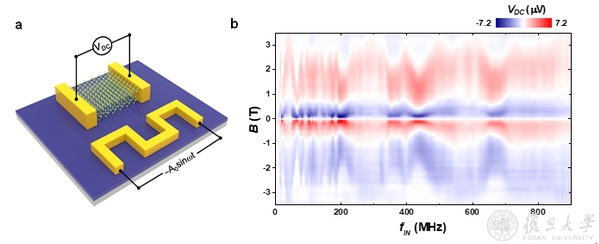Recently, our group has made significant progress in the research of nonreciprocal antennas for two-dimensional layered superconductors NbSe2. On November 6th, the relevant research findings were published online in the journal Nature Communications 115634 (2020) under the title of “Nonreciprocal Superconducting NbSe2 Antenna”. The first unit of the paper is the Department of Physics at Fudan University, with Professor Faxian Xiu as the corresponding author and postdoctoral fellow Enze Zhang as the first author.
In recent years, two-dimensional layered single crystal superconducting materials have become a research focus of great concern internationally. Compared to traditional amorphous and polycrystalline superconducting thin films, two-dimensional layered single crystal superconducting materials, due to their extremely high single crystal quality, can maintain their superconducting state up to the thickness of the original cell layer at the nanoscale. This makes it possible to detect the novel properties of intrinsic two-dimensional superconductivity in samples, and also provides a new research platform for people to understand and regulate low-dimensional superconducting states, superconducting quantum phase transitions, and so on. Although two-dimensional layered single crystal superconducting materials have abundant quantum phenomena and huge potential application value in new functional nano devices, current research on two-dimensional layered single crystal superconducting materials is mostly focused on physical properties, and research on new functional devices based on two-dimensional layered single crystal superconductors is still in a blank state.

Figure. (a) Schematic diagram of superconducting NbSe2 antenna device. (b) 2D Spectral Response of Superconducting NbSe2 Antenna Devices
In order to construct a new functional device based on two-dimensional layered single crystal superconductors, we first prepared high-quality single crystal niobium selenide blocks and successfully dissociated high-quality two-dimensional single crystal superconducting niobium selenide with a thickness of 1-5nm using tape mechanical stripping method. Interestingly, through transport measurements, it was found that below the superconducting temperature, the second harmonic magnetoresistance isotherm curve of the sample exhibits a multi peak anti symmetric characteristic. Through further analysis and research on the second harmonic magnetoresistance signals under different currents, it was found that this is due to the reversible electromagnetic chirality effect caused by symmetry breaking, which corresponds to a double gamma value (reflecting the intensity parameter of electromagnetic chirality effect) that is much higher than that of traditional non superconducting systems.
Based on this reversible electromagnetic chirality effect, our group designed and prepared nanoscale superconducting NbSe2 antenna devices. In the superconducting state, due to the net velocity of vortices in NbSe2 being driven by an external electromagnetic field, the device can achieve non reciprocal reversible detection of electromagnetic wave signals applied to the outside world. When electromagnetic waves are radiated from the antenna device, the device can stably generate DC voltage and current signals, and continuously and stably output energy (work) to the outside world. At the same time, this device can detect electromagnetic wave signals as small as 1 microwatt, and the detection spectrum width of the device can reach 5MHz-900Mhz.
This work fills the gap in device research based on two-dimensional single crystal superconductors in the world, and is of great significance for the practical device applications of new two-dimensional single crystal superconductors. This research work indicates that two-dimensional layered single crystal superconductors are a very good device implementation platform for energy collection, detection, and recognition of electromagnetic waves in the radio frequency and even higher frequency bands. Especially, this nanoscale superconducting antenna device can work under extremely low temperature conditions and has potential application prospects in future superconducting quantum computing circuits.
Paper link: https://www.nature.com/articles/s41467-020-19459-5